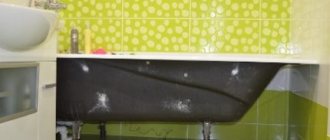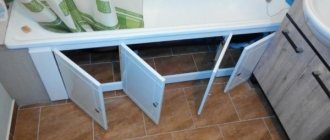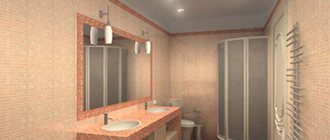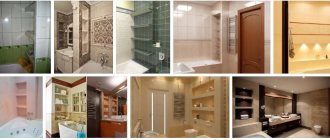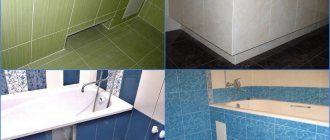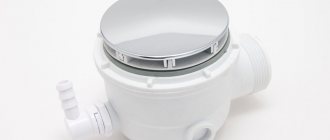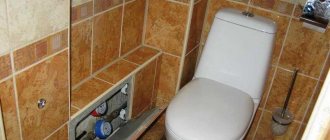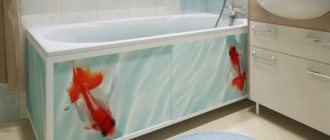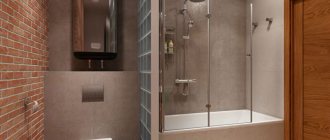Bathroom renovation is a long process, starting with the creation of a design project and ending with the installation of furniture and plumbing. Homeowners place particularly high demands on the quality and aesthetic characteristics of finishing in rooms with high humidity.
According to the latest trends in construction, most communications or pipes are, if possible, hidden from view using special structures called boxes. They must reliably mask elements of the plumbing and sewerage system or wiring that are unnecessary in the interior.
To bring the appearance of the washing container to the ideal by hiding the siphon or unsightly legs, you will need a screen for a plasterboard bathtub. In this article we will tell you how to choose the material for making the screen, as well as how to assemble it yourself.
Why make a screen under the bathroom?
The walls and floor in the bathroom are tiled, and the plumbing is installed in its place and connected to communications. Everything looks great. The only problem that spoils the view is the space under the bathtub from its side down.
In order for the interior of the room to look harmonious and complete, it is necessary to somehow close the bathhouse itself and the pipes connected to it.
The main purpose of the decorative screen under the bathtub is to hide the unpresentable-looking legs and outer side of the bathtub from the eyes of the owners
If the bathing plumbing is made of acrylic or plastic, then in most cases it looks quite decent from the outside. On the contrary, cast iron or steel products do not please the eye. They must be decorated from the outside, otherwise the bathroom will not look too neat.
Housewives often store detergents and other household essentials under the bathroom. It is advisable to cover all this, as well as communications, with a decorative screen.
A screen like this is a great way to hide what is unnecessary and not too beautiful to look at. All these jars, bottles, rags and pipelines will be securely hidden behind it from people’s view.
If the bathroom is tiled, then it is recommended to make the screen under the bathtub from it as well. This way the design of this room can be decorated in a single, complete style.
The main thing when installing this decor is not to forget about the need to have access to communications. You will need to make a hatch in the screen, through which in case of leaks you can get to the pipes for repair.
Features of using moisture-resistant drywall in the bathroom ↑
When choosing plasterboard for finishing work in wet rooms, you should pay attention to the color of the sheets. A material with an outer layer of green (sometimes blue) cardboard is required. Only this type can withstand dampness and not collapse. This is a durable material with good heat and sound insulation characteristics. From it you can build not only a screen for the bath, but also sew up communications with a box that are otherwise impossible to hide. Using metal profiles and moisture-resistant drywall, vertical and horizontal boxes are mounted.
Bathroom shelves can be made from plasterboard
To store cosmetics and household chemicals, you can make multi-tiered shelves. First, to do this, you need to build a structure from a metal profile or wooden beams, and then cover them with sheet material.
Using plasterboard in the bathroom, you can quickly level the walls and build a suspended ceiling. An important condition must be observed: the ventilation must be powerful enough to ensure air exchange. Otherwise, moisture will cause the spread of mold, which can render even moisture-resistant plasterboard unusable.
Possible design options
Bathtubs vary in shape, material and functionality. But the methods of decorating the space underneath them using tiles are the same in all cases. It is necessary to make a reliable base for the tile, and then glue it according to all the rules and rub the seams.
When installing a decorative partition, you must remember the need for a niche for the feet, and also do not forget about the hatch, which facilitates access to sewer pipes
Structurally, screens under the bathroom can be:
- with hinged or sliding doors;
- removable or permanent;
- with retractable drawers, designs with or without shelves;
- deaf and with a niche at the bottom for feet.
The easiest way to lay tiles is under the side of the bathtub. When using it, you do not have to waste effort on carefully aligning the new edge.
It is enough to lay the top row of tiles under the side of the bathhouse or vertically flush with it. An additional plus is that the frame and rough surface for gluing ceramics in this case will also be easier to make.
If you decide to use ceramic tiles to line a niche under the bathroom, then the easiest way is to make a blank solid screen out of it without any frills. However, in case of blockages and leaks, it will not allow access to communications. It will need to be torn down and then re-decorated. It’s difficult to call such a decision thoughtful.
A blank tiled screen is easy to install and looks elegant, but if the bathtub siphon gets clogged or the pipes under it burst, then this decor will have to be destroyed without the possibility of restoration
A more practical option is with an inspection door or window. When installing such a screen, a technological hole is provided, closed with a plastic hatch or a removable panel the size of one tile. It turns out both presentable and practical.
Screens with sliding or swinging doors made of tiles are extremely difficult to make. The tile must be glued to a strong and undistorted base. But in the case of openable and closed door leaves, this is impossible to achieve. The tile will inevitably fall off from such a surface.
The bathtub is often used for bathing babies and washing clothes. At the same time, you have to stand close to her. If there is no niche made near the floor or the screen does not have a downward slope downwards from the edge of the bowl, then there will be nowhere to put your feet in this situation.
Standing nearby, you will have to bend deeper, unnecessarily straining your back. When decorating a bathtub, be sure to provide a recess for the feet.
The final stage of screen installation
At this stage you need:
- treat all joints of sheets with special self-adhesive tape - serpyanka;
- cover with rough putty all places where screws are screwed in, as well as joints;
- all irregularities should be cleaned off with sandpaper;
- Next, we apply the final putty, which should perfectly level the surface. If minor irregularities are detected after the putty has dried, we rub them with sandpaper.
After this, you can begin the final finishing. Since this is still a bathroom, the niches are most often finished with ceramic tiles to match the color of the overall interior. In this situation, you should glue the tiles, and not use cement-sand mortar as a fastening agent. This approach will allow you to significantly reduce the load on the structure and speed up the final finishing process.
How to glue tiles to a plasterboard screen
The tiles should be glued as follows:
- prime the drywall;
- apply the adhesive solution to the tiles and to the work surface;
- The tiles should be laid so that the seams in the niche coincide with the seams between the tiles on the walls.
Note! For beauty, cut the outer corners of the tiles at 45 degrees.
In addition to ceramic tiles, you can use water-repellent paint. This is a less popular and preferred finishing option, but it is also sometimes found. If there are doors, they can be covered with plastic or simply painted.
Other finishing options are practically not used here, since the microclimate of the room will very quickly spoil their appearance.
If you follow the above instructions exactly, your under-bath screen will not only be beautiful, but also functional. Having this design will make your bath much more attractive.
Choosing ceramics for a bathtub panel
Ceramic tiles with glaze are impervious to moisture and durable. It is easy to maintain and install. Its only drawback is the fragility of the glazed layer; it easily cracks when struck. But if you don’t throw heavy objects at the tiles, then this problem is not so relevant and significant.
The markings on the box allow you to quickly navigate the assortment of ceramic tiles; for a screen in the bathroom, a cheap wall-mounted one that is not frost-resistant will suffice
The dimensions of most baths are modest. It is recommended to choose small or medium sized tiles for decorating the space underneath. Large slabs will have to be cut, which means extra residue and potential losses from cracking of the glaze due to inaccurate cutting.
You can also use mosaics to cover the screen. However, laying out a pattern from small elements is time-consuming and labor-intensive. It’s easier to choose ready-made mosaic modules in the form of sheets of fiberglass mesh with ceramics already glued to it. They will simply need to be cut out and fixed to a partition made of plasterboard or brick.
Disadvantages of the material
No matter how good the material is, it has its drawbacks and gypsum board is no exception:
- no matter how the gypsum board is processed for moisture resistance, it does not withstand prolonged contact with water;
- plasterboard structures cannot withstand heavy loads.
As you can see, there are few shortcomings and all of them can be eliminated by using one or another drywall installation technology. In addition, you need to buy moisture-resistant material. Types of drywall:
- ordinary slabs, which are used in dry, ventilated rooms, the color of these slabs is gray;
Example of a purchased functional screen
- moisture-resistant green material, for wet rooms with temperature changes;
- fire-resistant gypsum plasterboard - pink sheets treated with special compounds that increase the fire resistance of gypsum plasterboard.
Once we have decided that we need to buy moisture-resistant plasterboard, it is worth considering what needs to be prepared before installation. We will need material and a standard set of tools.
Nuances of gluing tiles
The final cladding of the partition formed under the bathtub is done using tile adhesive or liquid nails. The first option is applied to the back side of the tile with a notched trowel, and the second option is applied from a tube at several points along the perimeter and in its center.
The first tile of the tile is glued in one of the upper corners and leveled using a level, the rest will be placed next to it
To prevent the tiles from floating to the sides, plastic crosses are inserted between them, allowing you to accurately control the size of the seams between the tiles. The latter, after completion of the cladding, are subject to mandatory grouting. Otherwise, water will get under the ceramic through them, which will sooner or later lead to its falling off.
Installation of a frame made of profiles for plasterboard
After purchasing the material, we begin installing the frame from the profiles. Before installing the frame, you need to calculate the thickness of the future screen. The thickness of the screen is the width of the profile plus the thickness of the drywall plus the thickness of the tiles plus the thickness of the tile adhesive layer plus 3-4 mm. The last 3-4 mm is a small margin for the tile to fit under the edge.
Further along the building level, mark the vertical edge of the side on the wall. To do this, place a level against the edge of the side of the wall and draw a vertical line along the level.
From this line, measure the calculated thickness of the screen and draw another line. This is the level at which you need to install the first frame guide profiles (at the top and bottom along the bathroom).
Install the lower guide profile. Glue a special sealing tape for drywall between the profile and the floor. The profile itself is attached to self-tapping screws and dowels.
Since there is nothing to attach the upper guide profile to, we install it simultaneously with the outer side vertical posts. We fasten the vertical posts along the previously marked vertical marks of the frame.
We fasten the profiles together with 19 mm metal-to-metal screws or a profile cutter (if available).
In the same way we mount the shelf frame at the head of the bathroom.
The racks for the purchased hatch are mounted and the hatch is fitted in place. If the hatch is heavy, which is most likely, then in the post on which the hatch hinges will be attached, or on both posts if the hatch is on a frame, you need to place wooden blocks in the spacer. The bars are placed inside the PS profile and attached to it with metal-wood screws 25-32 mm.
The frame is ready, let's move on to working with drywall sheets
Construction of a removable screen
In addition to rigidly fixed structures, to decorate the space under the bathroom, make a removable panel.
To create a mobile screen you will need:
- OSB;
- tile;
- furniture legs adjustable in height;
- slats 20x40 mm to create a frame for supports.
First, a piece is cut from the OSB sheet with such dimensions as to completely cover the side of the bathtub. Only they make it slightly smaller in height, about five centimeters. The feet should fit freely into this gap from below. After cutting, the frame is stuffed onto the OSB, and the legs are attached to it.
The base of the removable screen for a bathtub with tiled cladding is made of oriented strand boards, which, due to their internal structure, are durable and resistant to moisture
Tile tiles are glued onto a wood base using standard technology using sealants and grout mixtures. After grouting the seams, the resulting screen can be placed against the bathtub and the legs can be adjusted so that it stands level in its place.
By twisting the supports, its upper edge must be pressed against the side of the bath from below, then this decorative panel will stand motionless.
Advantages of drywall
Drywall is a well-known building material that is convenient to use for making a decorative screen for a bathtub, creating boxes, and quickly leveling walls or ceilings. It consists of rectangular sheets of cardboard with gypsum filler between them. This material is valued for the following qualities:
- Strength. Drywall has high strength and is not afraid of mechanical stress.
Drywall
- Ease of processing. To work with drywall, you do not need to acquire expensive tools. You can cut the sheet with your own hands using a regular sharp knife, and fix it on the frame using a screwdriver and special self-tapping screws.
- Flexibility. Craftsmen even create curved screens with rounded corners from this material. To give the sheet the desired shape, it is treated with a needle roller and wetted. When wet, drywall bends easily.
- Variety of finishes. At the final stage of work, the screen for a plasterboard bathtub can be painted, finished with decorative plaster or tiled with ceramic tiles to create a holistic image throughout the entire room.
- Affordable price. Drywall sheets and the profile required for fixing are inexpensive, which is why this material is most often used to make bath screens with your own hands.
Note! The bathroom has a humid microclimate, so the finishing materials used for work are constantly in direct or indirect contact with water. Therefore, to make a screen for a bathtub with your own hands, use moisture-resistant plasterboard, which is marked with the abbreviation GKLV and painted green or blue. The sheet thickness should be 10-12 mm, depending on the type of cladding.
Bathtub cladding of complex shapes
If the bathhouse has curved contours, then a regular screen with tiles cannot be installed on it. The plasterboard base can be made of any shape. But then it’s unlikely to be possible to glue large ceramic tiles to it. Ceramics does not bend, it can only be broken.
However, it is quite possible to cover a screen with a complex configuration with arched outlines using mosaics. Its small pieces are ideal for this purpose. It is not afraid of moisture and will last in the bathroom for many years.
Mosaics can be used to cover a bathtub with any contours; it allows you to easily follow all its curves and bulges
For cladding a bathhouse or jacuzzi, both mosaics in the form of individual pieces and ready-made modules on a flexible mesh are suitable. The first method is labor-intensive and long. It is much easier to use modules with mosaic elements already pasted under a given pattern. With their help you can easily follow the contour of the bowl.
In addition to tiling, there are various options for decorating the space under the bathroom. One of the original methods is a mirror screen. Alternative methods for creating a screen and technologies for their implementation are described in this article.
Tools and materials
To install a screen under a plasterboard bathtub we will need:
- Control and measuring instrument (construction square, tape measure, level) + pencil;
- metal scissors, assembly knife, electric drill + 6 mm drills for metal, tiles and concrete and a screwdriver;
- fastening elements (metal screws, screws with a press washer, dowel-nails);
- GKL moisture-resistant and metal supporting profile for drywall;
- polyurethane foam, deep penetration primer, wide brush, tile adhesive and notched trowel;
- tile grout, tiles, inspection hatch.
Products with inspection hole
The screen is a slightly modified type of solid partition. The main difference is the presence of a technological opening - a door or window. This option is more practical than the previous one. The inspection hole provides access to communications located under the bathroom. It can be fully used to check or repair the sewer system. The window is often closed, but it may also be left open.
Screen with inspection hole
Forming a base for tiles
Plasterboard sheets on a frame
The advantages of this material are strength, resistance to mechanical stress, ease of processing, flexibility (important when making custom-shaped screens) and relatively low cost.
Required tools and materials:
- mounting level;
- roulette;
- marker;
- screwdriver, hammer drill;
- guide and rack metal profiles or wooden beams;
- hammer;
- scissors for cutting metal;
- self-tapping screws, plastic dowels;
- primer, roller and brushes;
- drywall.
Stages of frame manufacturing:
- determine the outer boundary of the partition, keep in mind that there will also be facing material on top of the drywall. Along the walls adjacent to the side parts of the bathtub, mark the line for installing the beam or profile so that it is deepened from the edge of the bowl by the thickness of the cladding;
- connect the resulting vertical marks with a horizontal line on the base of the floor, controlling its evenness relative to the sides of the bowl with a plumb line;
- Drill holes along the perimeter of the line with a hammer drill in increments of 150-200 mm, hammer in the dowels;
- cut the guide profile or beam to appropriate sizes, secure with self-tapping screws; additionally glue it to the base of the floor with sealant;
- fasten the vertical rack profiles with a pitch of 600 mm. If a technological hole is left, install additional racks in this place; when installing a niche for the feet, install the floor profile in the shape of the letter U with a recess for the bathtub (the racks in the niche are installed at an angle);
- cut the drywall according to the measurements, keep in mind that the material is attached at a distance of 1 cm from the floor and the edges of the bathtub bowl - this prevents the material from swelling;
- fix the drywall to the frame with self-tapping screws;
- Insulate the seams and joints with sealant and coat the material with a primer.
If using a wooden beam as a frame, coat the material with a special antiseptic. It is advisable to make the structure from moisture-resistant grades of plasterboard (green sheets).
Brickwork
A brick bath screen is considered a solid base and is most suitable for tiling, but the installation process requires significant labor.
Required tools:
- trowel (trowel for masonry);
- polyurethane foam;
- a mixture of cement and sand;
- container for mixing the solution;
- building level;
- hammer for chopping bricks;
- bricks.
Frame installation includes the following work:
- calculate the required amount of material, taking into account the size of the brick and the masonry technology (a quarter or half a brick);
- Use a level to mark the floor and walls of the bathroom. The laying is done so that the edge of the bathtub protrudes beyond the brick wall by 2 cm - the tiles laid on a layer of adhesive will be recessed under the side;
- slightly moisten the floor surface - this will improve the adhesion of the frame to the base;
- mix the solution in accordance with the brand of cement used;
- carry out masonry from one wall to another, with bricks offset in each subsequent row, taking into account the need to leave a technological hole or niche for feet;
- leave a gap of 2-3 cm between the side of the tank and the last row; after the solution has dried, fill it with foam;
- plaster the brick frame.
You can check the evenness of the masonry during installation using a rope stretched between the outer bricks of the row.
Partition made of tongue-and-groove slabs
Construction gypsum or silicate products are an alternative material, which is a hollow slab measuring 667x500x80 mm, with a support (with a groove) and a connecting (with a ridge) side. To make a bath screen, a moisture-resistant type of board is used.
Required tools:
- mounting level or plumb line;
- roulette;
- tile adhesive or gypsum plaster;
- acrylic primer;
- metal spatula;
- wood hacksaw;
- slabs
Carrying out work on making a screen for a bathtub:
- clean surfaces from dust and debris;
- Apply primer to the base;
- transfer the points of the outer boundary of the bathroom to the floor using a level or plumb line, draw a line along the resulting marks. If the tank is located in the center of the room, mark the perimeter;
- step back another 5 mm into the space under the bathtub from the markings and draw a new line - this is the outer border of the screen (if you follow the rule, the facing tiles will not protrude beyond the side of the bowl);
- prepare the adhesive solution for work;
- Apply the mixture using a spatula to the groove and ridge of the slab, install the product in the desired location, and join adjacent elements. The thickness of the seam at the joints should be no more than 2 mm; adjust the position of the blocks by pressing or lightly tapping;
- check the position of the masonry with a level;
- If you need to cut the material, make markings on the tiles and cut them using a hacksaw.
When fixing elements with tile adhesive, tongue-and-groove blocks do not need to be wetted with water; When using gypsum plaster, each element must be moistened before installation.
